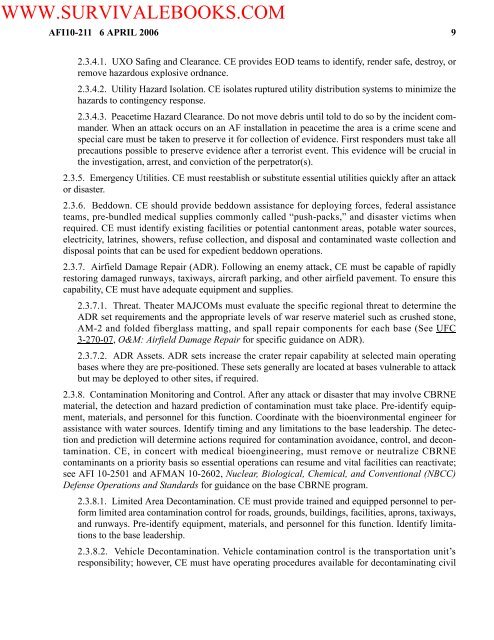2006 US Air Force CIVIL ENGINEER ... - Survival Books
2006 US Air Force CIVIL ENGINEER ... - Survival Books
2006 US Air Force CIVIL ENGINEER ... - Survival Books
- No tags were found...
You also want an ePaper? Increase the reach of your titles
YUMPU automatically turns print PDFs into web optimized ePapers that Google loves.
WWW.SURVIVALEBOOKS.COMAFI10-211 6 APRIL <strong>2006</strong> 92.3.4.1. UXO Safing and Clearance. CE provides EOD teams to identify, render safe, destroy, orremove hazardous explosive ordnance.2.3.4.2. Utility Hazard Isolation. CE isolates ruptured utility distribution systems to minimize thehazards to contingency response.2.3.4.3. Peacetime Hazard Clearance. Do not move debris until told to do so by the incident commander.When an attack occurs on an AF installation in peacetime the area is a crime scene andspecial care must be taken to preserve it for collection of evidence. First responders must take allprecautions possible to preserve evidence after a terrorist event. This evidence will be crucial inthe investigation, arrest, and conviction of the perpetrator(s).2.3.5. Emergency Utilities. CE must reestablish or substitute essential utilities quickly after an attackor disaster.2.3.6. Beddown. CE should provide beddown assistance for deploying forces, federal assistanceteams, pre-bundled medical supplies commonly called “push-packs,” and disaster victims whenrequired. CE must identify existing facilities or potential cantonment areas, potable water sources,electricity, latrines, showers, refuse collection, and disposal and contaminated waste collection anddisposal points that can be used for expedient beddown operations.2.3.7. <strong>Air</strong>field Damage Repair (ADR). Following an enemy attack, CE must be capable of rapidlyrestoring damaged runways, taxiways, aircraft parking, and other airfield pavement. To ensure thiscapability, CE must have adequate equipment and supplies.2.3.7.1. Threat. Theater MAJCOMs must evaluate the specific regional threat to determine theADR set requirements and the appropriate levels of war reserve materiel such as crushed stone,AM-2 and folded fiberglass matting, and spall repair components for each base (See UFC3-270-07, O&M: <strong>Air</strong>field Damage Repair for specific guidance on ADR).2.3.7.2. ADR Assets. ADR sets increase the crater repair capability at selected main operatingbases where they are pre-positioned. These sets generally are located at bases vulnerable to attackbut may be deployed to other sites, if required.2.3.8. Contamination Monitoring and Control. After any attack or disaster that may involve CBRNEmaterial, the detection and hazard prediction of contamination must take place. Pre-identify equipment,materials, and personnel for this function. Coordinate with the bioenvironmental engineer forassistance with water sources. Identify timing and any limitations to the base leadership. The detectionand prediction will determine actions required for contamination avoidance, control, and decontamination.CE, in concert with medical bioengineering, must remove or neutralize CBRNEcontaminants on a priority basis so essential operations can resume and vital facilities can reactivate;see AFI 10-2501 and AFMAN 10-2602, Nuclear, Biological, Chemical, and Conventional (NBCC)Defense Operations and Standards for guidance on the base CBRNE program.2.3.8.1. Limited Area Decontamination. CE must provide trained and equipped personnel to performlimited area contamination control for roads, grounds, buildings, facilities, aprons, taxiways,and runways. Pre-identify equipment, materials, and personnel for this function. Identify limitationsto the base leadership.2.3.8.2. Vehicle Decontamination. Vehicle contamination control is the transportation unit’sresponsibility; however, CE must have operating procedures available for decontaminating civil
















